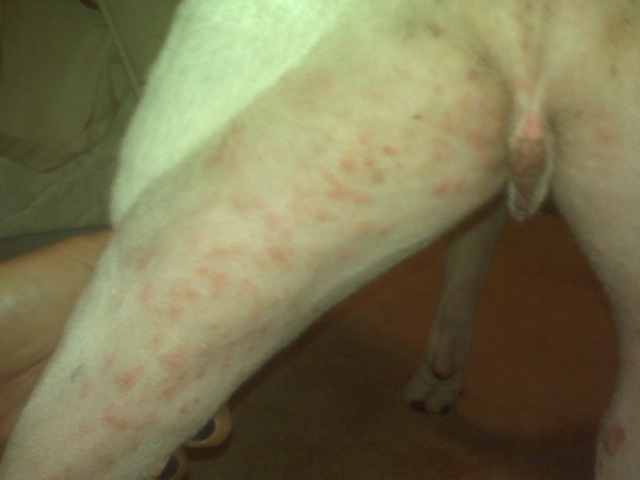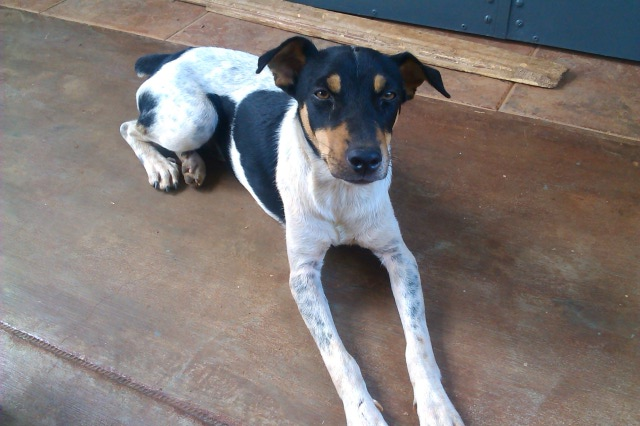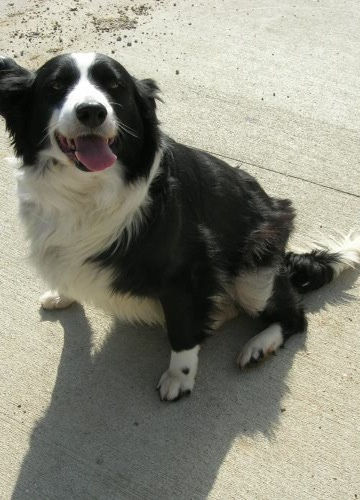QuestionI rescued a 10 month old toy manchester terrier in June. The reason she was rescued is because the previous owner gave her as a Christmas gift to their 2 boys and they definitely were not dog people. They would leave her in her cage about 16 ours a day. They finally got fed up with her when she started pooping and peeing in her cage during the day. Trixie is almost 15 months old now. She is totally house trained and has been since we brought her home. She tells us when she needs to go out with no problem. We also have another TMC that is 3 years old and when we leave the house we have them trained to stay in their cage. At the beginning, every time we would put her in the cage she would most of the time pee and poop. I stooped the peeing be taking all blankets and anything fabric out of the cage, she now is on the bare floor of the cage. This totally worked for the peeing problem, it has stopped. Then we noticed that as long as we made sure she poops before we put her in the cage she would be fine and not poop. Now she seems to be regressing. Almost every time we put her in her cage she poops and then eats it to hide it! One time she actually vomited it all up. She does this whether she is in the cage 10 minutes or 2 hours. I spoke with the previous owners and they said that was a large problem and the reason why they gave her to the rescue group. They couldn't take having to bath her and clean up every time they came home. When I first brought her home I would make the cage very small and not give her much room. as she stopped I gave her the full cage, which the cage is small anyway. The cage my other dog is in is much larger. The other day when I came home I noticed she pooped and ate it. I reprimanded her and didn't even raise my voice, just asked her what she did and that she needs to do poopies outside. She was shaking like a leaf. This makes me think that the previous owners may have beat her for it. When I put her in her cage it isn't for a very long time. Once in a while she may be in for 5 hours but it is usually an hour or two and it is not every day. When I tell her to go in her "house" she runs right in. She started doing that after about a week or two of us having her. I am at my wits end and don't know how to break this. Can you help?
AnswerNobody ever solved any problem by punishing a dog after it did something. Unless you actually catch the dog in the act, punishing it only creates fear and confusion. Have you talked to the rescue group about the problem? What suggestions did they give? Perhaps work at building her confidence and bonding with you.
Start with obedience training. The key to most behavior problems is approaching things using the dog's natural instincts. Dogs see all the people and dogs in the household as a pack with each having their own rank in the pack and a top dog. Life is much easier if the 2 legged pack members outrank the 4 legged ones. You can learn to play the role of top dog by reading some books or going to a good obedience class. A good obedience class or book is about you being top dog, not about rewarding standard commands with a treat. Start at http://www.dogsbestfriend.com/ As you praise the dog for following your commands, it will build its confidence.
Play tug of war with the dog and lose. However at the end of the game, take the rope or toy and put it up, less the dog becomes confused about who is top dog. Ropes from the pets' store quickly turn to hazardous shreds. Ones I made lasted much better. Go to a hardware or home center that sells rope by the foot. Buy 2' of 3/4" poly rope. Melt the ends, and tie knots in it. Get them as tight as possible, put it in a vise and pound it with a hammer. Watch carefully, and be ready to discard when it comes apart.
''Elevation for small puppies: Sit on the floor and gently put your hands around your pup's middle, below his front legs, and lift him up. He is facing you. Hold him for 15 seconds. Repeat until he no longer struggles. If he is past 10-12 weeks, lift his front feet off the ground, but don't pick him up.
Cradling for small puppies: Hold your puppy gently on his back, as you would cradle a small baby. If he struggles, hold him firmly until he quiets for 10-15 seconds. With larger pups, you can do this as your sit on the floor, with your pup between your legs.
Quiet lying down: Place your pup on the floor on his side, with all 4 legs pointing away from you. Use your hands on his neck/shoulder area and middle, to hold him in this position. When he is quiet, praise him. Lengthen the time that you keep him quietly in this position. When he accepts this position well, handle his paws and muzzle, while keeping him quiet.''
The quotes mean this isn't my original work. It is copied from my Puppy Raising Manual. I have long used these or minor variations of them, and they are very effective. You may want to give him a belly rub while he is on his back too. Helps bonding. There is a big difference between him rolling over and demanding a belly rub, and you choosing a time to roll him over and rub his belly. The latter cements your place as pack leader.
Have you tried the peanut butter in the Kong trick? She could be too busy licking it out to stress out over being left in the crate.
Some medicine from the vet might help until she develops confidence that you will be back before too long.

 Live worms came out in my dogs poop and he has some rashes?
Question
The Rashes
She is 15 months old and is
Live worms came out in my dogs poop and he has some rashes?
Question
The Rashes
She is 15 months old and is
 Temperature before birth
QuestionQUESTION: My female cheweenie is on day 52 of h
Temperature before birth
QuestionQUESTION: My female cheweenie is on day 52 of h
 Large dog with possible poison ivy
Question
Guero
My poor dog has led a rough life to date
Large dog with possible poison ivy
Question
Guero
My poor dog has led a rough life to date
 Dog breed confusion
Question
photo of Toby 1 photo of Toby 2
H
Dog breed confusion
Question
photo of Toby 1 photo of Toby 2
H
 dog who growls and nips
Question
Ladybug
We adopted a rescue dog, Ladybu
dog who growls and nips
Question
Ladybug
We adopted a rescue dog, Ladybu